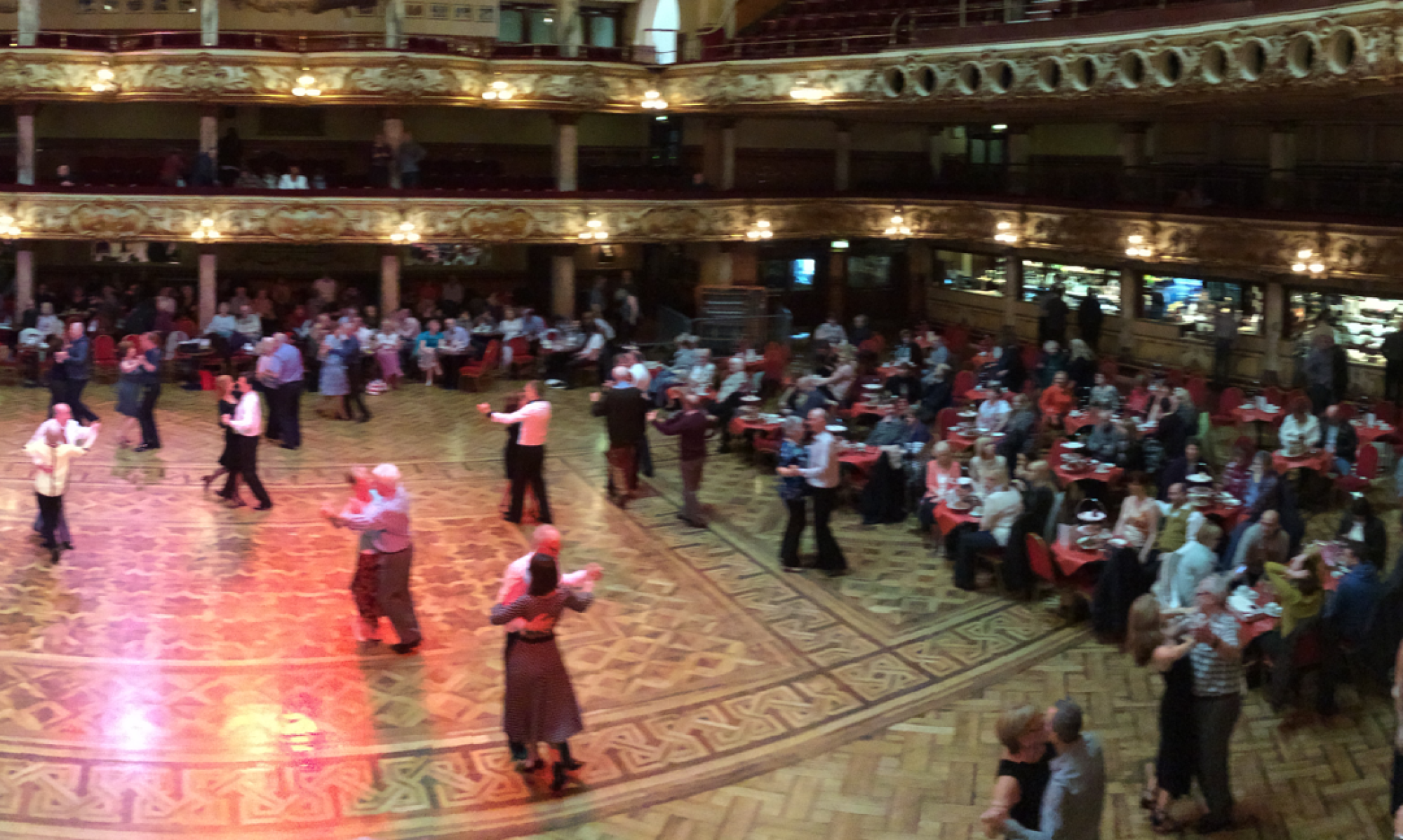You’re finally ready to start moving with your dance partner to some of the more common ballroom patterns. These patterns are used in multiple dances, but the leads and follows are virtually the same. I recommend you make sure you know the footwork already. Follower instructions will be italicized after the leader’s instructions.
Fifth Position Breaks
- From closed position (CP), step side with the LF, and open your LH and make a scooping action out and downwards, changing to the hand-hold below.
I call it, kissing-the-lady’s-hand hold.
Release your right hand (RH) from the follower’s back.
Followers will feel their frame guiding them to step side with their RF.
When he removes his RH, release your left hand (LH) and place it on your hip.
Imagining your left arm (LA) is in a cast, turn 1/8 right and take a small step back. Your LH should turn with you.
Followers, keep tone in your right arm (RA), so the rotation of the arm 1/8 left transfers into the body and causes it to turn the same amount. Step back with the momentum.
Both sides maintain frame and replace weight.
Turn 1/8 left and step side, maintaining tone and front position of LA so your dance partner continues to mirror you. Reconnect with your RH in CP.
Tone in the RA should be enough for followers to feel a 1/8 right turn and side step. Reconnect with your LH.
Turn 1/8 left and lead sideways with the elbow to guide you and your dance partner to step back.
Followers, you’ll feel you’re being pulled off your feet. Let your body open 1/8 right and step back to ‘catch’ yourself.
Both sides maintain frame and replace weight.
Crossover Breaks
- Scoop and change your left hand hold as above. Make a side step with your RF, turning 1/8 to the right as you do, and release the RH. Again, keep tone in your LH so it also turns 1/8 right.
Followers, increase tone in the RH so your body turns 1/8 left with your arm.
Turning another 1/8 right (with the LA still in front), step forward.
Followers, maintain tone so you can feel the lead to step forward with your partner.
Both sides maintain frame and replace weight.
Maintaining tone, turn 3/8 left, and step side. Clearly offer your RH, and release the LH.
Followers keep tone, and you will be led to turn 3/8 right, facing a spot just to the left of your partner. When he offers his RH, take it with your left.
Repeat on the other side, with opposite legs.
Open Break
- Start as with crossover breaks, but continue to face forward. As you finish your weight transfer, let your body and LA press forward into your partner’s RA. Your LA should bend slightly, like a spring.
Since your leader has increased the pressure after you taken your step, you can’t step back immediately. Instead, equalize the pressure by pushing back (your arm should also bend slightly). Remember to release your LH.
Push yourself away from the connection by extending your LA, like you’re pushing off a wall, and step back.
Followers, resist the pressure, but let it move you to step back as well. This should extend both his and your arms.
Pull yourself back to the connection with the LA, like you’d pull yourself to a handhold while mountain climbing. Change your weight forward as you do this.
Followers resist the pull by keeping your elbow bent, and transfer your weight forward.
Underarm Turn (UAT)
- Leaders step side with the LF, releasing the LH and raising it just above your dance partner (keep the elbow down). Increase the pressure slightly with the LH as you finish the weight change. For a left turn, use the opposite foot and hand.
Followers, let your RH rise, and step to the side. Like the open break, compress your hand slightly to resist the increased pressure.
Over the next 3 steps, release the pressure slightly, and circle your forearm clockwise, in a smooth and continuous movement around your partner’s head (counter-clockwise for a left turn), keeping the elbow still. Your footwork is less important, but avoid stepping into your dance partner.
Followers keep your RA still, and respond to the release of pressure by following the connection around your head, making a 1/4 turn right and stepping forward, then twisting 1/2 right and changing weight, and finally turning another 1/4 right and stepping to stand in front of your dance partner. Avoid turning faster or slower then you are led.
The turn is sometimes made with a forward step for the follower, followed by two 1/2 turns to right, but the lead is basically the same.
So, are you confused yet? Don’t worry, the last section in this series covers some final tips that will make it easier to understand. See you next week!
